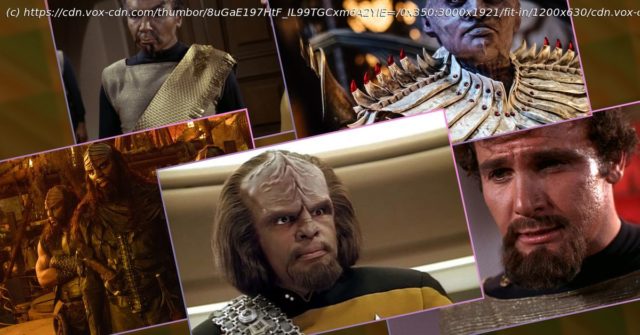Star Trek: Strange New Worlds season 2 features Klingons in its new episode. It’s just the latest in a wild saga about alien makeup for the TV and movie franchise.
Apart from the benevolent pointy-eared Vulcans, there’s no fictional alien species more iconic than the Klingons — not only in Star Trek, but in pop culture at large. The spacefaring warriors have evolved over half a century from generic Cold War antagonists into a complicated and spiritual culture that evokes both medieval Vikings and feudal samurai. There is a complete, functional Klingon language studied and spoken by fans around the world, who routinely don the familiar armor and forehead ridges at fan conventions. Most people who are even casually familiar with Star Trek would recognize a Klingon should one pass by on the street (perhaps in Las Vegas, this or any August), and even applaud the remarkable accuracy of their makeup and attire.
And yet, there is not, nor has there ever been, one definitive Klingon makeup design. Despite fan uproar practically every time a substantive change is made to the craggy foreheads and wispy beards of the space conquerors, their look has been in flux from the beginning, and will likely continue to evolve along with the production technology behind Star Trek itself. In honor of the return of a more familiar appearance in the season premiere of Star Trek: Strange New Worlds, we’ve taken a deep dive into the rocky history of science fiction’s most famous forehead, from 1966 to today.The brownface era
The Klingons were introduced during the first season of Star Trek, in the 1967 episode “Errand of Mercy.” Writer/producer Gene L. Coon used the story’s conflict between the United Federation of Planets and the rival Klingon Empire over a non-aligned planet as an allegory for Cold War proxy conflicts, but — according to the exhaustively researched book These Are the Voyages: TOS, Season One by Marc Cushman and Susan Osborn — offered only the barest physical description for the new antagonists. In the terse and insensitive parlance of a 1960s television producer, Coon referred to the Klingons merely as “hard-looking Asian types.”
It fell to makeup artist Fred Phillips and actor John Colicos (who had been cast as the episode’s lead Klingon, Kor) to decide what the character — and species — would look like. Colicos takes credit (or blame) for the Klingons’ original look, asking for a “vaguely Asian” makeup effect patterned after conqueror Genghis Khan. At Colicos’ direction, Phillips applied bushy eyebrows, a Fu Manchu, and a heavy layer of greenish-brown makeup to Colicos’ face to make him appear “not of this world.”
Though this became the accepted canonical 23rd-century “TOS-era” look, the Klingons’ appearance actually fluctuated over the course of the series. In season 2’s Klingon stories, “Friday’s Child” and “The Trouble with Tribbles,” no false eyebrows or dark makeup were used on the (exclusively white) Klingon actors, only short beards, some of them very obviously prosthetic. The brown face paint would return in season 3, and all Klingons who appeared in its short-lived sequel, Star Trek: The Animated Series, would have a brown or orange hue to their skin. This includes individual Klingons who had previously appeared without dark makeup.
There are two major takeaways to any study of the early history of Klingon makeup design. First, that there has never been a point when the look of the Klingons wasn’t changing, and second, that we’re very lucky it did. Ardent Star Trek canonistas rail against any change to Star Trek as a production that cannot be easily explained in-universe, and for almost 40 years, the ever-changing Klingon forehead was exactly that. But maintaining the canon — either through offensive makeup or typecasting — is a dicey proposition.
In short: Change is good.Enter the latex
When Star Trek made the leap to the big screen for 1979’s Star Trek: The Motion Picture, advances in makeup effects and a much larger budget allowed for the Klingons to receive a complete visual overhaul. Costume designer Robert Fletcher drew the first sketches of the new Klingons, adding a single knobby ridge that extended from the spine to the bridge of their nose. Fletcher wanted the Klingons to look as alien as possible, like a moloch lizard, but according to Fletcher, Star Trek creator Gene Roddenberry strongly disagreed with this and wanted the Klingons to appear mostly human. The two came to a compromise, which Fletcher calls “a hairy crustacean.” Fletcher considered the Klingons’ forehead ridges to be the vestigial remains of a species that once had a rigid exoskeleton, a concept that was also incorporated into their costume design.
This concept was translated into a latex makeup design by Original Series makeup artist Fred Phillips and future Oscar-winner Ve Neill, along with a team that included makeup assistant Rick Stratton. By some accounts, it was Stratton who suggested that the Klingons should also have gnarly dental prosthetics, a suggestion that he claims was made mostly to assure himself an extra day’s paid work. Stained, jagged teeth would remain a constant.
Fletcher was called upon to further refine the new forehead design for Star Trek III: The Search for Spock. From here on out, rather than having the appearance of a single, thick spine that wrapped all the way up their necks and down to their noses, which obscured most actors’ faces beyond recognition, Klingons would appear to have a bony but less pronounced plate under their foreheads. The Search for Spock also established the idea of Klingon men growing out their hair.
This became the basic blueprint for the iconic Klingon, with makeup effects from this era being reused for years to come.
Start
United States
USA — software Star Trek has never known exactly what Klingons look like, until now...






